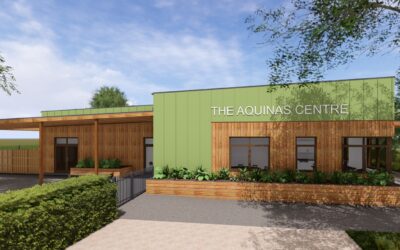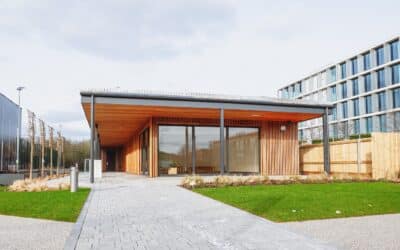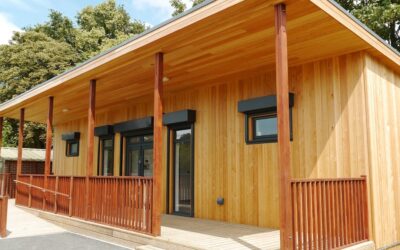TG Escapes Blog
How Tailored Environments Benefit SEND Students
As we look to better accommodate students falling under the Special Educational Needs and Disabilities (SEND) umbrella, it’s become more and more clear that traditionally designed classrooms can cause a range of issues, leading to challenges in engagement, behaviour, and academic outcomes. Effective SEND classrooms incorporate elements like access to nature, breakout spaces, and sensory-sensitive features, which can significantly improve focus, reduce stress, and support better learning.
Designing these spaces with attention to natural light, acoustics, and accessible layouts can lead to marked improvements, with a range of studies showcasing the positive impact on pupils. While changes can be made to existing buildings, ultimately the best approach is to build bespoke facilities from the ground up around SEND requirements, as our team does.

What SEND students need
Supporting SEND students requires a comprehensive approach due to the vast range of needs that fall under the umbrella, from physical disabilities and sensory impairments to learning difficulties and emotional or behavioural challenges. To effectively meet these diverse needs, schools must implement tailored support systems that include careful assessment, monitoring, and the provision of necessary resources. This could involve measures like Education, Health, and Care plans (EHC plans).
Another crucial measure when educating students with SEND needs is utilising spaces that are tailored towards creating comfortable, focused, and happy learning environments for them.
The crucial design factors for an SEND learning space
Supporting students with SEND begins with the design of their learning spaces. Elements like natural light, sound management, and breakout spaces can greatly improve focus, reduce stress, and enhance overall well-being. A thoughtful design process would look to prioritise several key factors:
Classroom Size

Classroom size is a critical factor in creating effective learning environments for SEND students. Government regulations specify larger spaces per student within SEND classrooms, with clear size guides for different types of needs, including physical disabilities and pupils with severe autism. If you’d like to find out more about the recommended class sizes, we have a guide on our website.
Another crucial aspect of improving SEND classrooms comes from reducing class sizes. A study from UCL took a specific look at SEND pupils, showing that in larger classes, students with SEND needs often received less overall teaching and more critical feedback, leading to disengagement. Opting for smaller classrooms not only provides more space per student but also enables teachers to offer more personalised support, ensuring that each child receives the attention and tailored instruction they need to thrive.
This focus on appropriate classroom size and student-to-teacher ratios is essential for fostering an inclusive and supportive learning environment and avoiding current issues with disproportionate exclusion rates for SEND students.
Breakout spaces
Breakout spaces are essential in supporting SEND students, providing them with safe, quiet areas to retreat to when they feel overwhelmed. Research has shown that students with learning disabilities often experience anxiety during busy times, such as breaks or when moving between lessons.
These designated spaces offer a calming environment where students can regulate their emotions, engage in discussions, or simply take a moment to relax away from the hustle and bustle of the classroom. They can also be useful as a way to give students time out from class, and for dealing with complex behaviour issues.
Sensory-friendly elements

Sensory room at Pengwern College
Sensory-friendly elements are crucial in creating supportive environments for students on the autism spectrum. Sensory spaces in schools provide a safe, calming area where students can retreat to regulate their emotions, reducing anxiety and sensory overload. These spaces can be tailored with features like soft lighting, comfortable seating, and calming colours, creating a predictable and controlled environment.
Limiting overstimulation, be that from light, colours, or noise, is also important. Autistic pupils can find things like high noise levels deeply distracting and uncomfortable. This can be tackled through the use of acoustic panelling, allowing students to focus and feel secure in a classroom.
Nature access
Access to nature and outdoor learning is vital for SEND students, providing unique benefits that traditional classrooms may not offer. Engaging with the outdoors can help reduce stress, improve focus, and enhance social skills, especially for those who may find indoor environments overwhelming. Activities like gardening, exploring natural settings, and outdoor reading sessions offer sensory stimulation, promote independence, and encourage hands-on learning.
These experiences not only support academic achievement but also foster emotional well-being and resilience, making outdoor learning an invaluable part of education for SEND students. This can be implemented through outdoor classrooms, simple exterior access, and regular trips to local nature areas.
Access
Making SEND environments accessible for all students should be a top priority, allowing them to fully participate in school activities alongside their peers. Building Bulletin 102 recommends a simple, clear layout that is easily understood by all users, broad circulation routes that accommodate wheelchairs and mobility aids, and several key ergonomic details like accessible door handles. Escape routes must also be tailored to meet the needs of disabled individuals, ensuring safety for all.
The best way to implement these standards
Implementing these standards in traditional, existing buildings can be challenging but is achievable with thoughtful adjustments. Schools can reduce class sizes to allow more individualised attention, add sensory-friendly elements, and improve acoustic insulation to minimise disruptive noise. Prioritising outdoor activities can also provide natural sensory experiences to students.
However, the most effective way to meet these standards is to prioritise them from the start of the design process. By doing so, you can build appropriately sized classrooms, with seamless access to breakout spaces and additional areas like changing places fascilities. This approach also allows for optimal acoustic design, ensuring a quiet, focused environment. A bespoke design process will help schools prioritise nature access, both through outdoor access and external classrooms, alongside biophilic design within the rooms themselves.
Our work in SEND

Our team specialises in creating beautiful, sustainable modular buildings from timber, offering ideal solutions for SEND needs. Over the past 21 years, we have partnered with SEND and mainstream schools on SEND projects that prioritise the well-being and success of their students. Starting with a bespoke design, our approach ensures that crucial aspects like accessibility, sensory-friendly spaces, and acoustic insulation are integral from the start.
Here are just two of our recent SEND projects:
- Woking High School: We were approached by Surrey County Council who wanted a brand new space at Woking High School tailored around visually impaired students. Combining 3 classrooms, breakout spaces, offices and toilets, our bespoke solution offered the pristine SEND space they needed, while also achieving net zero in operation.
- Sir Charles Parsons School: Catering to teenagers with a range of additional needs, Sir Charles Parsons School, worked with us on two additional buildings for their site, combining several classrooms with auxiliary spaces. We implemented specialist features such as reinforced walls to aid with hoists and external ramps. Our team were also able to prioritise outdoor access through decking while still achieving an A+ energy rating.
Working with TG Escapes
We collaborate with SEND schools across the UK, offering a panelised modular solution that excels across our bespoke building projects. We regularly incorporate breakout spaces, exterior access, specialist facilities like changing spaces, and excellent levels of acoustic insulation. Every one of our projects starts with a free design process, including a fully costed price for the finished building. To find out more, speak to a member of our team.
About the author
More posts from our blog
Education Estates 2025: Surrey County Council Share Their SEND Provision Strategy, Including the Contribution Made by TG Escapes
At the recent Education Estates 2025 conference, I was proud to join Euan Leslie, Programme Manager for our partners Surrey County Council as we presented their ambitious and highly successful strategy for expanding Special Educational Needs and Disabilities (SEND)...
The Benefits of Choosing a Modular Clubhouse Building
A clubhouse needs to serve many functions, from creating social spaces and meeting areas to offering changing rooms and toilet facilities for players. Modular buildings are an ideal solution for creating flexible, purpose-built facilities for sports teams,...
Supporting Active School Life With Modular Sports Pavilions
Physical activity is a crucial part of everyday schooling across the UK. But in many settings, ageing facilities and limited space can prevent pupils from getting the full benefit of PE, sport, and outdoor recreation. Modern sports and leisure pavilions offer an...



